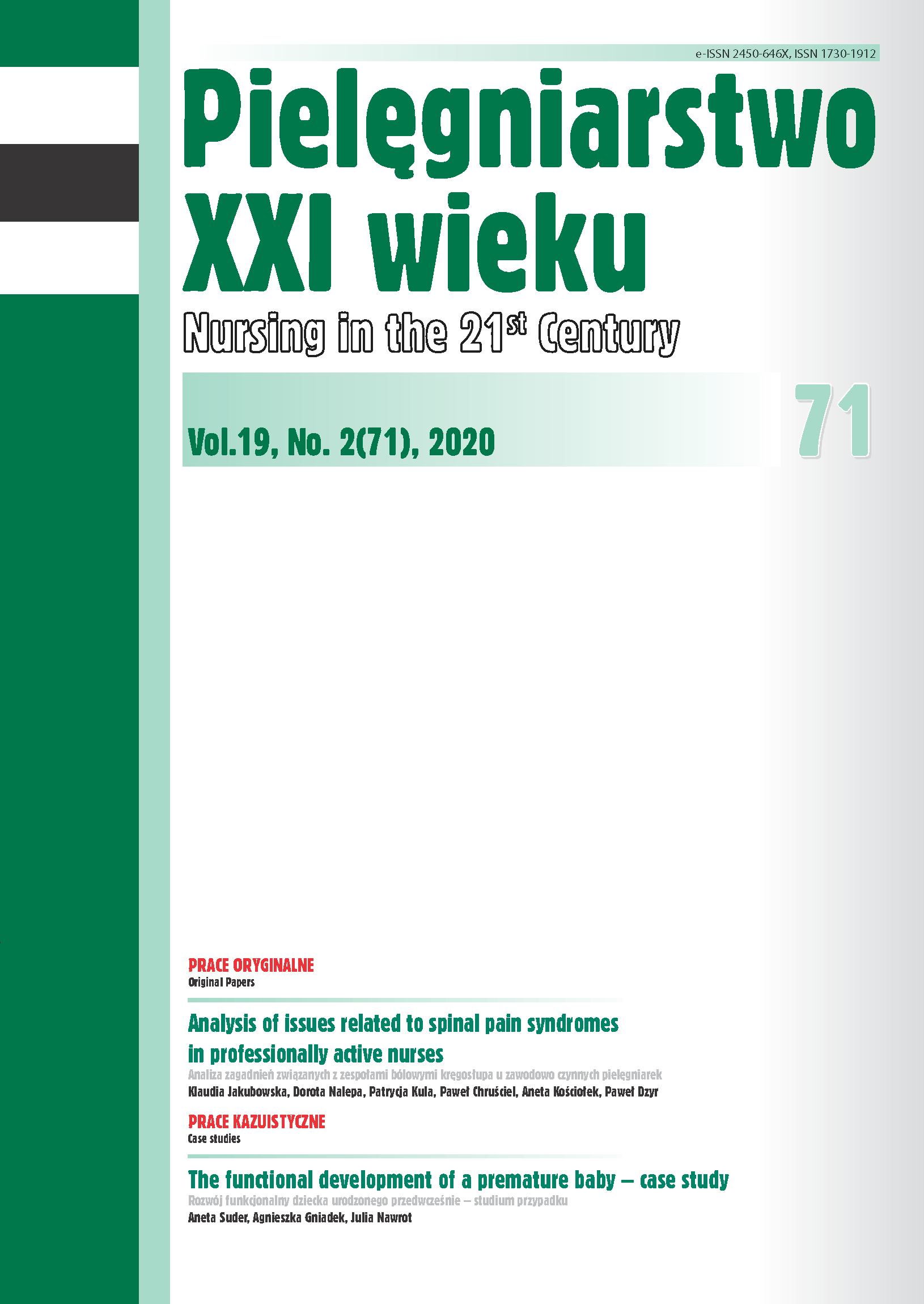Analysis of issues related to spinal pain syndromes in professionally active nurses
DOI:
https://doi.org/10.2478/pielxxiw-2020-0014Keywords:
pain, backbone, occupational disease, nursing staffAbstract
ANALYSIS OF ISSUES RELATED TO SPINAL PAIN SYNDROMES IN PROFESSIONALLY ACTIVE NURSES
Aim. The aim of the study was to analyze the assessment of issues related to the occurrence of spinal pain in professionally active nurses.
Material and methods. The study group consisted of 145 nurses. The diagnostic survey method was used in the study using a questionnaire technique. The research tool was the original questionnaire (sociodemographic data and questions about opinions on the occurrence of spinal pain). The NRS scale was also used in the study.
Results. The vast majority (99%, n=143) of respondents declared that they felt spinal pains. The largest group indicated that the most common location of pain was the lumbar spine (56.55%, n=82). It was shown that there is a statistically signifi cant relationship between the use of sick leave and the intensity of the pain (χ2=24.101, p<0.05) and the subjective perception of the degree of disability (χ2=35.8300, p<0.05). A significant statistical relation between the place of work and the section of the spine most frequently affected by pain (χ2=12.719, p<0.05) was demonstrated.
Conclusions. The work as a nurse contributes to the occurrence of spinal pain. There is a connection between the place of work and the occurrence of pain syndromes. Spinal pain contributed to absence from work. Seniority at work has an impact on the occurrence of spinal pain. Nursing staff has knowledge about spinal saving techniques. The occurrence of spinal pain syndromes affects the functioning in everyday life.
References
1. Gorbaniuk J, Chuchra MM. The Meaning of Professional Work in the Life of Nurses − Comparative Study. Roczniki Teologiczne. 2019;66 (1): 105-122.
2. Dziubak M, Motyka M. Perception of the nursing proffesion by nursing students in the course of education at undergraduate nursing studies. Pielęgniarstwo Polskie. 2019;72 (2).
3. Booker LA, Barnes M, Alvaro P et al. The role of sleep hygiene in the risk of Shift Work Disorder in nurses. Sleep. 2020;43 (2). DOI: https://doi.org/10.1093/sleep/zsz228
4. Poikkeus T, Suhonen R, Katajisto J, Leino-Kilpi H. Relationships between organizational and individual support, nurses’ ethical competence, ethical safety, and work satisfaction. Health Care Management. 2020;45(1): 83-93. doi: 10.1097/ HMR.0000000000000195
5. Mazur M. Aggression among nurses. Pomeranian Journal of Life Sciences. 2019;65 (4): 61-66. DOI: https://doi.org/10.21164/pomjlifesci.636
6. Sykut A, Massalska K, Dobrowolska B. Elements of nurses’ professional image in electronic media and their contexts. The opinion of professionally active nurses. Pielęgniarstwo XXI wieku. 2016;1 (15): 43-49. DOI: 10.1515/pielxxiw-2016-0007
7. Jabłońska R, Gralik M, Królikowska A, Haor B et al. The Problem of Back Pain Among Nurses of Neurology and Neurosurgery Wards The Problem of Back Pain Among Nurses of Neurology and Neurosurgery Wards. The Journal of Neurological and Neurosurgical Nursing. 2016;5(3): 84-91. DOI: 10.15225/PNN.2016.5.3.1
8. Kramer J, et al. Ćwiczenia w zakresie bezbólowym [w:] Choroby krążka międzykręgowego. Wrocław: ELSEVIER Urban & Partner; 2013, s. 363.
9. Adamaszek M, Włoszczak-Szubzda A. Częstotliwość występowania bólu kręgosłupa u personelu medycznego. Aspekty zdrowia i choroby. 2018;3(1): 133-151.
10. Tworek K. Praca zawodowa a bóle kręgosłupa u pielęgniarek pracujących w szpitalach. Współczesne Pielęgniarstwo i Ochrona Zdrowia. 2017; 1: 19-22.
11. Maciuk M, Krajewska-Kułak E, Klimaszewska K. Samoocena występowania zespołów bólowych kręgosłupa u zawodowo czynnych pielęgniarek. Probl Hig Epidemiol. 2012; 93(4): 728-738.
12. Kramer J, i wsp. Zespół lędźwiowy, [w:] Choroby krążka międzykręgowego, tłum. Dziak A. Wrocław: ELSEVIER Urban & Partner; 2013, s. 288.
13. Bugajska J, Jędryka-Góral A, Gasik R, Żołnierczyk-Zreda D. Nabyte zespoły dysfunkcji układu mięśniowo-szkieletowego u pracowników w świetle badań epidemiologicznych. Medycyna Praktyczna. 2011;62(2): 153-161.
14. Kołpa M, Zawiślak E, Jurkiewicz B, Grochowska A. Stan funkcjonalny pacjentów poddanych leczeniu operacyjnemu z powodu dyskopatii odcinka lędźwiowego kręgosłupa. Pielęgniarstwo XXI wieku. 2015;53(4): 51-54. DOI: 10.12923/p21w-2015- 4/50
15. Stelcer B, Bilski B. The phenomenon of job stress and burnout syndrome in palliative care. Medycyna Pracy. 2020;71(1):1-10. DOI: https://doi.org/10.13075/ mp.5893.00852
16. Bortkiewicz A, Szyjkowska A, Siedlecka J, Makowiec-Dąbrowska T, et al. Selected chronic diseases and their risk factors in teachers. Medycyna Pracy. 2020;71 (2):1-11.
17. Tworek K. Professional work and the spinal pain syndrome in the group of nurses employed in hospitals. Współczesne Pielęgniarstwo i Ochrona Zdrowia. 2017;6 (1): 19-22.
18. Kabiesz P, Ciukaj J, Galbas M, i wsp. Ocena stanu zdrowia studentów w kontekście bólu kręgosłupa. Zeszyty Naukowe Politechniki Śląskiej. Organizacja i Zarządzanie. 2018. z. 131 Zarządzanie współczesną organizacją: 183-194.
19. Garczyk D, Jankowski R, Misterska E, et al. Patient satisfaction with nursing after surgery due to cervical or lumbar discopathy. Medical Science Monitor. 2013;19:892-902.
Downloads
Published
Issue
Section
License
Copyright (c) 2020 Authors

This work is licensed under a Creative Commons Attribution-NonCommercial-NoDerivatives 3.0 Unported License.




